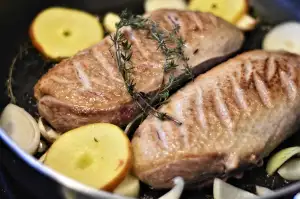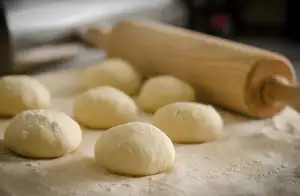Master the Art of Making Roux: A Flavorful Recipe for Your Culinary Creations

- Understanding the Basics: Ingredients and Equipment Needed
- Step-by-Step Guide to Making Roux: Achieving the Perfect Consistency
- Exploring Variations: Different Types of Roux for Various Dishes
- Tips and Tricks for Cooking with Roux: Enhancing Flavors and Avoiding Common Mistakes
- Recipe Ideas: Delicious Dishes that Incorporate Roux
Roux, a classic French cooking technique, is a versatile and essential ingredient in many culinary creations. Made by combining equal parts fat and flour, roux acts as a thickening agent and adds depth of flavor to sauces, soups, and stews. Its creamy texture and rich taste make it a staple in kitchens around the world. Whether you're a seasoned chef or an aspiring home cook, mastering the art of making roux will elevate your dishes to new heights of deliciousness. So let's dive into the world of roux and unlock its flavorful potential!
Understanding the Basics: Ingredients and Equipment Needed
To master the art of making roux, it's essential to understand the basics. The ingredients needed are simple: equal parts fat and flour. Common fats used include butter, vegetable oil, or animal fat like bacon grease. As for equipment, a heavy-bottomed saucepan or skillet is ideal for even heat distribution. A whisk or wooden spoon will help to blend the fat and flour smoothly. With these basic ingredients and tools in place, you're ready to embark on your flavorful culinary adventure.
Step-by-Step Guide to Making Roux: Achieving the Perfect Consistency
1. Start by gathering your ingredients: equal parts flour and fat, such as butter or oil. You'll also need a whisk or wooden spoon and a heavy-bottomed saucepan.
2. Melt the fat over medium heat until it's hot but not smoking. Gradually add the flour, stirring constantly to incorporate it into the fat.
3. Continue stirring the mixture for about 5-10 minutes, or until it turns a golden brown color. Be careful not to let it burn, as this will give your roux a bitter taste.
4. Adjust the heat if necessary to maintain a steady temperature. The key is to cook the flour slowly to allow its starches to break down and thicken the mixture.
5. Once you've achieved the desired color, remove the saucepan from heat and let the roux cool slightly before using it in your recipe.
6. Depending on your dish, you can use your roux immediately or store it in an airtight container in the refrigerator for up to a week.
7. Remember that different recipes may call for different consistencies of roux - from light (for soups and sauces) to dark (for gumbo and stews). Adjust cooking time accordingly.
8. Practice makes perfect when it comes to making roux, so don't be discouraged if your first attempts aren't flawless. With time and experience, you'll master this essential culinary technique!
Exploring Variations: Different Types of Roux for Various Dishes
Roux is not a one-size-fits-all ingredient. Depending on the dish you are preparing, different types of roux can be used to enhance flavors and achieve desired consistencies. The three main variations of roux are white, blond, and brown.
White roux is the mildest in flavor and is made by cooking equal parts flour and butter until it reaches a pale golden color. It is commonly used in delicate sauces like béchamel or velouté, where a subtle thickening agent is needed without overpowering the other ingredients.
Blond roux is cooked slightly longer than white roux, resulting in a nuttier flavor and a light golden color. This type of roux works well in dishes like soups, stews, and cream-based sauces, adding depth and richness without overwhelming the overall taste.
Brown roux is cooked until it reaches a deep caramel color and has a robust, almost smoky flavor profile. It adds complexity to dishes like gumbo or étouffée and provides a rich base for gravies or dark sauces. However, be cautious not to burn it as this can give your dish an unpleasant bitter taste.
Experimenting with different types of roux will allow you to tailor your culinary creations to suit your preferences and the specific dish you are preparing. Remember that the longer you cook the roux, the darker its color becomes and the stronger its flavor will be. So don't be afraid to play around with cooking times to find what works best for you!
Tips and Tricks for Cooking with Roux: Enhancing Flavors and Avoiding Common Mistakes
When cooking with roux, there are a few tips and tricks that can help enhance the flavors of your dishes and avoid common mistakes. Firstly, it's important to cook the roux slowly over low heat to prevent it from burning and developing a bitter taste. Stir constantly to ensure even browning.
To add depth of flavor, consider using homemade stock instead of water when making your roux. This will infuse your dish with rich, savory notes. Additionally, adding herbs and spices to your roux can elevate the overall taste profile.
Another tip is to gradually incorporate the liquid into the roux while whisking continuously. This will help prevent lumps from forming and ensure a smooth consistency.
Avoid using too much roux in your recipes as it can make the dish overly thick and heavy. Start with small amounts and gradually add more if needed.
Lastly, remember that roux continues to thicken as it cooks, so be mindful of this when determining how much liquid to add. Adjust accordingly to achieve the desired consistency.
By following these tips and tricks, you'll be able to master the art of cooking with roux and create flavorful culinary creations that will impress your family and friends.
Recipe Ideas: Delicious Dishes that Incorporate Roux
Now that you have mastered the art of making roux, it's time to put your culinary skills to the test with some mouthwatering dishes. Here are a few recipe ideas that will showcase the versatility and flavor-enhancing power of homemade roux.
1. Classic Chicken and Sausage Gumbo: This hearty Cajun dish is a perfect showcase for dark roux. Combine your homemade roux with chicken, sausage, vegetables, and spices for a rich and flavorful gumbo that will transport you straight to Louisiana.
2. Creamy Shrimp Etouffee: Take your taste buds on a trip to New Orleans with this creamy and indulgent dish. Start by making a blonde roux, then add shrimp, onions, bell peppers, celery, and garlic. Serve it over rice for a truly satisfying meal.
3. Beef Stroganoff: Elevate this classic comfort food by adding a touch of light brown roux to the sauce. The velvety texture and nutty flavor of the roux will take this dish to new heights of deliciousness.
4. Mushroom Risotto: Create a luscious and creamy risotto by incorporating white roux into the cooking process. The roux adds depth and richness to the dish while ensuring a perfectly smooth texture.
5. Macaroni and Cheese: Upgrade your mac and cheese game by using a blond or light brown roux as the base for your cheese sauce. The roux will give your sauce body and help it cling to every noodle for an irresistible cheesy delight.
These recipe ideas are just the tip of the iceberg when it comes to incorporating homemade roux into your cooking repertoire. Get creative in the kitchen and experiment with different types of roux in various dishes – from soups and sauces to casseroles and gravies – the possibilities are endless!
In conclusion, mastering the art of making roux will undoubtedly elevate your cooking to a whole new level. By creating your own homemade roux, you have the power to enhance flavors, thicken sauces and soups, and add a depth of richness to your culinary creations. Whether you're preparing a classic gumbo or experimenting with new recipes, roux is a versatile ingredient that can transform ordinary dishes into extraordinary ones. So why settle for store-bought when you can craft your own flavorful roux? With a little practice and experimentation, you'll soon be impressing friends and family with your culinary prowess. So go ahead, embark on this flavorful food adventure and let the magic of homemade roux take your cooking to new heights!
Published: 25. 01. 2024
Category: Recipes



